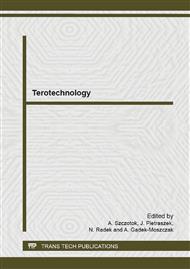p.101
p.107
p.113
p.119
p.127
p.133
p.139
p.145
p.151
Modelling of the Mechanical State of a Diamond Particle in the Metallic Matrix
Abstract:
The paper is concerned with the modelling of diamond retention efficiency of three different matrix materials: cobalt (EF), cobalt (SMS) and carbonyl iron powders. After the consolidation stage, the specimens were tested for tensile properties. The mechanical fields around a diamond particle were determined using computer simulations. The simulations were performed for a protruding diamond particle after hot pressing and after loading with an external force. The diamond retention efficiency of the matrix is affected by the interactions between the diamond crystal and the matrix during hot pressing. It is assumed that the matrix potential for diamond retention is associated with the amount of elastic and plastic deformation energies. The mechanical state generated in the matrix was calculated using Abaqus software.
Info:
Periodical:
Pages:
127-132
Citation:
Online since:
January 2014
Authors:
Price:
Сopyright:
© 2014 Trans Tech Publications Ltd. All Rights Reserved
Share:
Citation:


